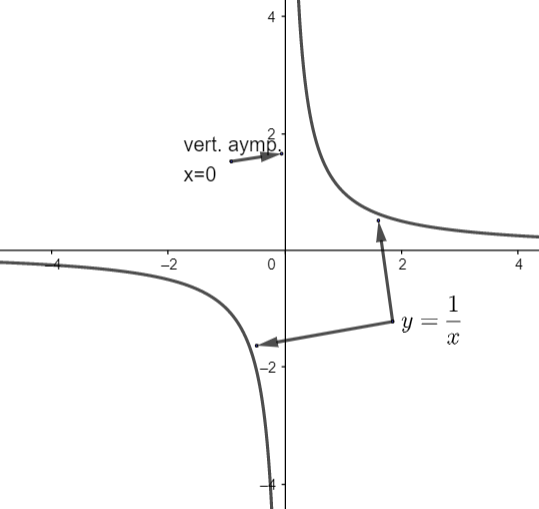
What is a vertical asymptote in calculus?
Answer
516.6k+ views
Hint: To solve this question you should know about the asymptotes or vertical asymptotes. Any vertical asymptote is a place where the function is undefined and the limit of that function does not exist. This is happening because as 1 approaches to the asymptote, even any small shift in the x – value leads to arbitrarily large fluctuations in the value of the functions.
Complete step by step answer:
According to our question we have to explain about the vertical asymptote in calculus.
So, in calculus a vertical asymptote is a place where the function is undefined and the limits of that function does not exist.
In simple words we can say that –
“Definition : The line \[x=a\] is called a vertical asymptote of the curve \[y=f\left( x \right)\] if at least one of the following statement is true: -
\[\begin{align}
& \underset{x\to {{a}^{-}}}{\mathop{\lim }}\,f\left( x \right)=-\infty \\
& \underset{x\to {{a}^{-}}}{\mathop{\lim }}\,f\left( x \right)=\infty \\
& \underset{x\to {{a}^{+}}}{\mathop{\lim }}\,f\left( x \right)=-\infty \\
& \underset{x\to {{a}^{+}}}{\mathop{\lim }}\,f\left( x \right)=\infty \\
& \underset{x\to a}{\mathop{\lim }}\,f\left( x \right)=-\infty \\
& \underset{x\to a}{\mathop{\lim }}\,f\left( x \right)=\infty '' \\
\end{align}\]
In this definition the superscript + denotes the right hand limits of \[f\left( x \right)\] as \[x\to a\], and the superscript – denotes the left hand limits of \[f\left( x \right)\] as \[x\to a\].
If we take an example and consider the function \[f\left( x \right)=\dfrac{1}{x}\], if we approach \[x=0\] from the left or right, \[f\left( x \right)\] becomes arbitrarily negative or arbitrarily positive respectively.
In this condition two of our statements are true from the definition. Especially the fourth and first. Therefore, we can say that:
\[f\left( x \right)=\dfrac{1}{x}\] has a vertical asymptote at \[x=0\]

Note: For any vertical asymptote point it is compulsory that it is satisfying at least any one point which is defined in the definition. If that is not satisfying any point then it can’t be possible to be a vertical asymptote at that point in that function’s curve. And this is mandatory for every function.
Complete step by step answer:
According to our question we have to explain about the vertical asymptote in calculus.
So, in calculus a vertical asymptote is a place where the function is undefined and the limits of that function does not exist.
In simple words we can say that –
“Definition : The line \[x=a\] is called a vertical asymptote of the curve \[y=f\left( x \right)\] if at least one of the following statement is true: -
\[\begin{align}
& \underset{x\to {{a}^{-}}}{\mathop{\lim }}\,f\left( x \right)=-\infty \\
& \underset{x\to {{a}^{-}}}{\mathop{\lim }}\,f\left( x \right)=\infty \\
& \underset{x\to {{a}^{+}}}{\mathop{\lim }}\,f\left( x \right)=-\infty \\
& \underset{x\to {{a}^{+}}}{\mathop{\lim }}\,f\left( x \right)=\infty \\
& \underset{x\to a}{\mathop{\lim }}\,f\left( x \right)=-\infty \\
& \underset{x\to a}{\mathop{\lim }}\,f\left( x \right)=\infty '' \\
\end{align}\]
In this definition the superscript + denotes the right hand limits of \[f\left( x \right)\] as \[x\to a\], and the superscript – denotes the left hand limits of \[f\left( x \right)\] as \[x\to a\].
If we take an example and consider the function \[f\left( x \right)=\dfrac{1}{x}\], if we approach \[x=0\] from the left or right, \[f\left( x \right)\] becomes arbitrarily negative or arbitrarily positive respectively.
In this condition two of our statements are true from the definition. Especially the fourth and first. Therefore, we can say that:
\[f\left( x \right)=\dfrac{1}{x}\] has a vertical asymptote at \[x=0\]

Note: For any vertical asymptote point it is compulsory that it is satisfying at least any one point which is defined in the definition. If that is not satisfying any point then it can’t be possible to be a vertical asymptote at that point in that function’s curve. And this is mandatory for every function.
Recently Updated Pages
Why are manures considered better than fertilizers class 11 biology CBSE

Find the coordinates of the midpoint of the line segment class 11 maths CBSE

Distinguish between static friction limiting friction class 11 physics CBSE

The Chairman of the constituent Assembly was A Jawaharlal class 11 social science CBSE

The first National Commission on Labour NCL submitted class 11 social science CBSE

Number of all subshell of n + l 7 is A 4 B 5 C 6 D class 11 chemistry CBSE

Trending doubts
What is meant by exothermic and endothermic reactions class 11 chemistry CBSE

10 examples of friction in our daily life

One Metric ton is equal to kg A 10000 B 1000 C 100 class 11 physics CBSE

1 Quintal is equal to a 110 kg b 10 kg c 100kg d 1000 class 11 physics CBSE

Difference Between Prokaryotic Cells and Eukaryotic Cells

What are Quantum numbers Explain the quantum number class 11 chemistry CBSE




